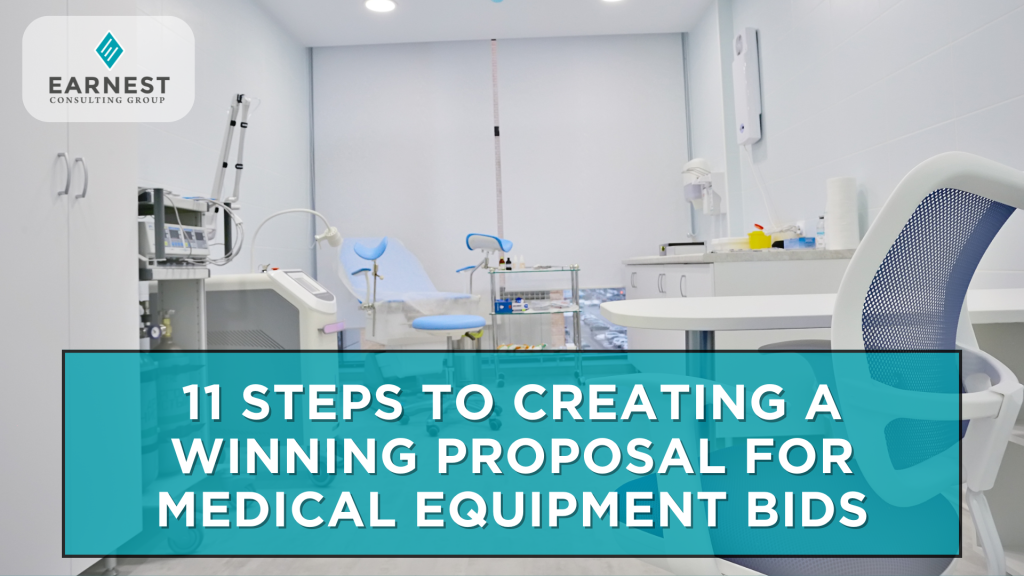11 Steps to Creating a Winning Proposal for Medical Equipment Bids
March 19, 2025 | Government
It takes more than submitting bids to be successful in the medical equipment space, but if you don’t know how to respond correctly to a bid, your sales efforts could be in vain.
Winning a government medical equipment bid is more than just submitting a quote and product information—it’s about demonstrating reliability, compliance, and value. With major buyers like the VA, DOD, and HHS procuring billions in medical equipment annually, positioning yourself correctly can set you apart from the competition. Here’s how to create a proposal that stands out and secures contracts.
1. Build a Relationship with Your Manufacturer BEFORE the Bid is Released
Strong relationships with your manufacturers are critical if you’re a distributor or reseller. The government often requires proof of authorization to sell specific equipment, and if you wait until a solicitation is released to secure these agreements, you may run out of time. Establish agreements early to ensure competitive pricing, set up terms that don’t require upfront payment, and avoid delays when responding to bids as well as setting up possible awards for success.
2. Understand the Buyer’s Needs
Before drafting your proposal, research the agency’s buying history. Look at past awards, contract values, and supplier trends to understand what agencies are purchasing and how. Identifying recurring needs helps tailor your approach to align with their procurement habits.
3. Follow the Solicitation Instructions to the Letter
Failure to follow submission guidelines—whether formatting, page limits, or required documentation—can result in automatic disqualification. If the bid asks for separate files for pricing and technical responses, follow those instructions strictly. When putting together a GSA Ebuy submission, still upload your quote template when they ask you to fill out their form.
4. Emphasize Compliance and Certifications
Medical equipment procurements often require compliance with FDA approvals, ISO certifications, and Trade Agreements Act (TAA) requirements. Clearly state how your products meet these standards and provide documentation to avoid delays or disqualification. Ensure your product meets the Nonmanufacturer Rule if set aside for SDVOSB, VOSB, 8(a), WOSB or HUBZone.
5. Highlight Past Performance
Past performance is often the deciding factor in a contract award. Include details such as the number of units delivered, contract values, and agencies served, even when it is not required in the instructions. List all of the orders you have received in the last five years for the product you are proposing to the government. The government is risk-averse and doesn’t want to be trailblazers. They want to see if other Federal health centers have also bought the product you sell.
6. Differentiate with Value, Not Just Price
While Lowest Price Technically Acceptable (LPTA) is sometimes used, many agencies now favor Best Value evaluations. This means they consider durability, performance, and support services in addition to price. Make a case for why your solution is the best long-term investment. Use quantifiable/qualifiable metrics when communicating this value. How many units sold? How many Federal health facilities have your products? How many patients are impacted? What is your geographical footprint?
7. Address Logistics and Support Services
Medical equipment procurement doesn’t end with the sale—delivery, installation, training, and maintenance are crucial. Even if the bid does not require end-to-end support, make sure to communicate that it IS available. Outline your service plan, including warranties and response times for maintenance requests.
8. Use Clear, Persuasive Writing
Avoid jargon and overly technical explanations unless necessary. Government evaluators need to grasp your value proposition quickly. Use bullet points, headers, and tables to highlight key differentiators concisely.
9. Price Competitively, But Profitably
Research competitor pricing through GSA Advantage, VA’s Medsurg Catalog Search, and historical contract data. Your pricing should be competitive yet sustainable. If allowed, offer volume discounts or bundled services to make your proposal more attractive.
10. Conduct a Compliance Review Before Submission
Many proposals are rejected due to missing signatures, incomplete forms, or incorrect formatting. Perform a final compliance check against the solicitation’s instructions to ensure all required attachments and certifications are included.
11. Submit Early and Follow Up
Avoid last-minute submissions that risk technical issues or incomplete uploads. Submit at least a day early and confirm receipt. Follow up with the contracting officer to verify submission and inquire about award timelines.
Winning government medical equipment contracts requires more than just a low price. It’s about demonstrating capability, reliability, and value. By following these 11 steps, you’ll improve your chances of securing contracts in this competitive space.
« Back to Blog Home




